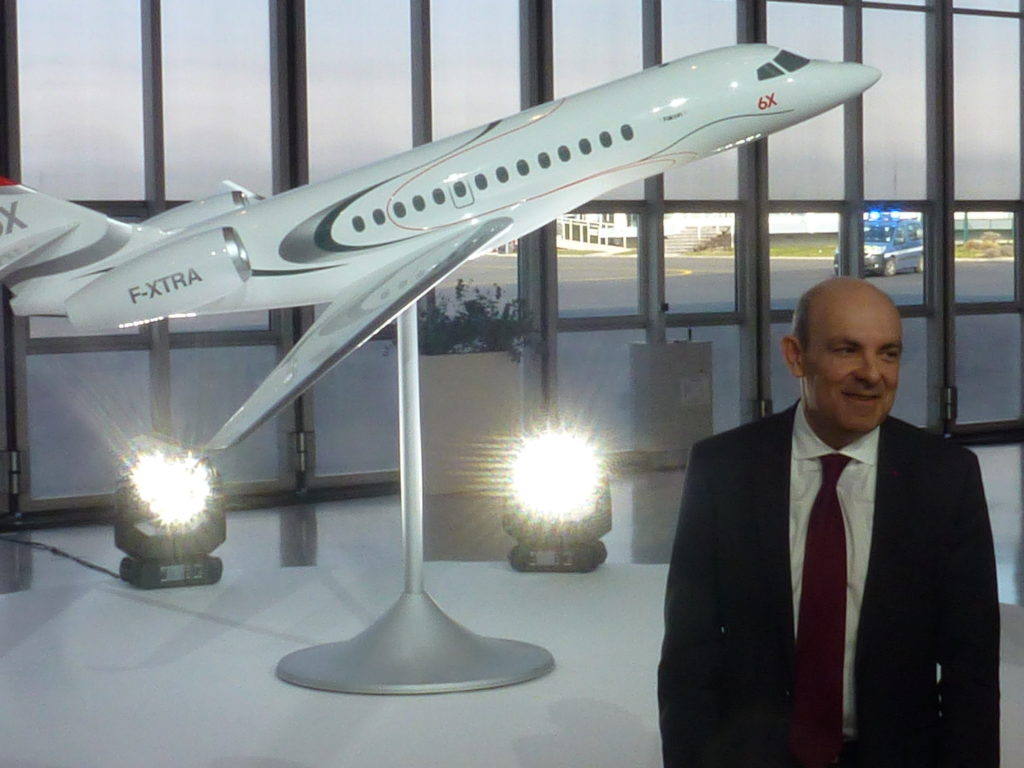
MONTRÉAL – Words count : 3097 – Reading timee : 12 minutes. Invited by the people of Dassault Falcon, I arrived just in time in Paris on Wednesday, February 28th, 2017 to attend the unveiling of a new Falcon business jet.
At 11:00, journalists and VIPs were invited to sit in front of an improvised stage in the very nice Dassault Falcon Service exhibition hall at Paris located at Paris – Le Bourget Airport (LBG).
On one side, three Falcons were exposed in the vast hangar and on the other, a stage, a giant screen and a curtain covering what is certainly the model of the all-new Falcon to be launched soon, without forgetting in a corner, a catering space provided by the great Parisian caterer Lenôtre.
Éric Trapier, CEO of Dassault Aviation was invited to speak in front of a hundred guests mostly journalists and Maria Della Posta, Senior Vice President, Pratt & Whitney Canada.
But the mystery remained whole until the last moment, the model of the new aircraft having kept under a cover until the middle of the event. Personally, I was sure that I will see the launch of a large cabin and ultra-long range Falcon business jet aimed to compete against the top of the line Gulfstream G650.
This presentation began with the projection of a video. Then Éric Trapier took the stage. The table was set.
With the help of a series of slides, Mr. Trapier unveiled the Falcon 6X, ‘the most spacious, advanced and versatile twinjet in business aviation’ according to him, renewing a battle with Savannah, Georgia-based Gulfstream Aerospace at the top end of the business jet market. For Dassault Aviation CEO, ‘There is still today a strong market need for a brand new long-range aircraft with a very large cabin. The Falcon 6X will be best value for money in the 5,000NM segment, a class all its own’.
During this day-long technical briefing, Dassault Falcon released details on its newest business jet, the Falcon 6X, a replacement for the 5X launched at the NBAA Business Aviation Convention and Exhibition (BACE) in Las Vegas, Nevada in 2013, a project canceled due to multiple delays in the development of its yet to be certified Safran Silvercrest engine. The Falcon 6X will be powered by a pair of 13,000 to 14,000lb thrust Pratt & Whitney Canada Pure Power PW812D (D for Dassault) engines. a version of the already certificated geared turbofans powering rival Gulfstream G500 with the PW814GA (GA standing for Gulfstream Aerospace) and G600 with the more powerful PW815GA. Equipped with a low maintenance single piece fan and emission reducing Talon combustor, the PW800 family which has logged more than 20,000 test hours features the common core technology of the Pratt & Whitney Geared Turbofan, which is shared by 16 different engine applications and have amassed over 585,000 flight hours.
From a maintenance perspective, the PW800 engine family sets the industry standard, with 40% less scheduled maintenance than other engines in its class.
According to Éric Trappier, the Falcon 6X is largely based on the Falcon 5X aerodynamics and system features which were validated during the 5X preliminary flight test program but at the same time, has been optimized around the Pratt & Whitney’s PW812D geared turbofan engine like the Falcon 5X was optimized around the Safran Silvercrest, a slightly less powerful jet engine, to take advantage of the new and more powerful engine, offering a greater range and a longer cabin.
‘We wanted to further push the boundaries with this new aircraft, to provide the best flight experience possible using today’s aviation know-how’ said Eric Trappier. He added that ‘The Falcon 6X will offer a mix of range, comfort and capability no other large cabin business jet can match while guaranteeing fully mature systems and a proven powerplant’.
The Falcon 6X is equipped with an ultra-efficient wing that minimizes the impact of turbulence and a next generation digital flight control system (DFCS) that controls all moving surfaces, including a novel control surface called a flaperon. The Falcon 6X is the first business aircraft to feature new flaperons, active high-speed deflection control surfaces that can act as both flaps (increasing lift) and ailerons (roll control). Integrated into the DFCS, flaperons are especially beneficial during approaches with a steep descent profile like London City Airport (LCY), increasing drag while maintaining a high-lift coefficient.
According to Mr. Trappier, ‘The 6X is a Falcon that raises the bar in terms of comfort, availability and mission capability’ by featuring ‘the most spacious cabin in the long-range segment’.
In fact, the Falcon 6X cabin is six feet, six inches (1.98m) high and 8 feet 6 inches (2.58m) wide offering the highest and widest cross section in a purpose-built business jet surpassing even the top of the line $65 million dollars Gulfstream G650 and is nearly 40 feet 8 inches (12.3m) long. The cabin can accommodate 16 passengers in three distinct lounge areas, affording room for multiple configurations including a large entry way/crew rest area and a spacious rear lounge. The extra width also means a 5-inch wider aisle compared to previous Falcons, for more elbow room and easier movement between cabin sections.
Every element of cabin style and design has been totally rethought, the result of an extensive survey of customer tastes and inputs from Dassault Aviation’s own in-house Design Studio.
Significantly more natural light floods into the cabin thanks to 29 extra-large windows with a total of 5000 square inches of glass including a unique galley skylight, the first in business aviation, designed to provide additional brightness in an area usually devoid of natural light.
Cabin air is refreshed continuously for an environment that is 10 times cleaner than today’s most advanced office buildings and cabin altitude pressurization is maintained at a very comfortable 3,900 feet (1,189m), when cruising at 41,000 feet (12,497m).
The Falcon 6X top speed will be Mach 0.90.
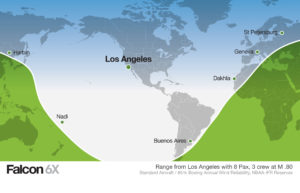
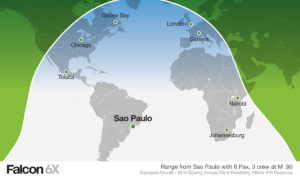
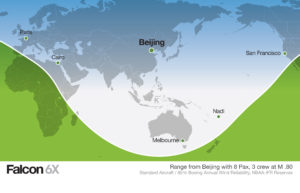
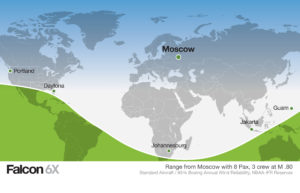 At Mach 0.80, its Long Range Cruise Speed, the Falcon 6X will fly 5500NM (10186KM) and perform the following flight:
At Mach 0.80, its Long Range Cruise Speed, the Falcon 6X will fly 5500NM (10186KM) and perform the following flight:
Los Angeles to Geneva
São Paulo to London
Beijing to San Francisco
Moscow to Singapore
London to Los Angeles

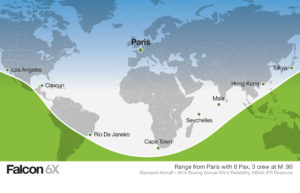 And at Mach 0.85, its maximum range is 5,100NM (9445 km) letting the Falcon 6X able to fly the following routes:
And at Mach 0.85, its maximum range is 5,100NM (9445 km) letting the Falcon 6X able to fly the following routes:
Moscow to New York
Paris to Beijing
Shanghai to Melbourne
Los Angeles to London
São Paulo to Chicago
Paris to Johannesburg
Thanks to the fact that the Falcon 6X is able to land with much more fuel than competing aircraft, it allows operators to make a short hop to an interim airport, pick up passengers, and then continue on to an overseas destination without having to refuel like flying from Washington to New York, then to proceed to London or Geneva without the need to fuel in New York.
Trapier underlined that he is planning to fly the aircraft in less than three years and have it on the market in just four, ‘an unusually tight development schedule which is challenging’.
The Mérignac-based airframer is confident of delivering the first production aircraft in 2022 and depending on market reaction, plans to ramp up to a production rate of about two aircraft per month in around 2023.
In 2018 economic conditions, the price of the Falcon 6X will be about 47 US dollars compared to 45 million for the 5X.
Then Olivier Villa, Dassault Aviation senior executive vice president, civil aircraft, joined the stage for a more technical briefing.
He stated the idea around which was designed the Falcon 6X: ‘We kept the basics of the 5X and optimized a new design around this new engine, adding about 300 nautical miles of range and 20 inches to the cabin’.
The Dassault Falcon 6X will featured an industry leading noise suppression system, based heavily on experience with the new Falcon 8X and an improved cockpit avionics package includes the third-generation EASy III system, powered by Honeywell’s Primus Epic platform. Among new features are an integrated controller-pilot data link communication (CPDLC) system and RDR 4000 IntuVue 3-D color weather radar that provides predictive lightning and hail detection as well as 60NM range Doppler turbulence detection. Hazardous weather and the vertical definition of thunderstorms can be seen at distances up to 320NM.
The 6X will be delivered with a full package of equipment, including Dassault’s FalconSphere II electronic flight bag and the FalconEye Combined Vision System, developed in partnership with Israel Elbit Systems, the first head-up display (HUD) to blend synthetic, database-driven terrain imaging and actual thermal and low-light camera images into a single view, providing an unprecedented level of situational awareness to flight crews in challenging weather conditions and all phases of flight. The Enhanced Vision System (EVS) function will eventually provide operational credits for bad weather approaches with 100 feet minimums, providing operators with a substantial operational benefit as well.
The Falcon 6X will also be equipped with next-generation Digital Flight Control System, the latest incarnation of the closed loop system Dassault has been using on existing Falcon jets, aims to increase maneuverability and cut down pilot workload.
All Falcon 6X systems and critical equipment will be extensively validated on the ground through new Highly Accelerated Life Tests and Highly Accelerated Stress Screening endurance campaigns intended to enhance reliability and ensure that the aircraft is fully mature from the day of first delivery.
Asked during the Questions & Answers session if Longueil, Québec based HérouxDevtek will design and supply the Falcon 6X nose and main landing gears as it was planned for the Falcon 5X, Mr. Trapier said it certainly would. During the afternoon briefings, in one of the PowerPoint presentations, HérouxDevtek was specified as the Falcon 6X nose and landing gears supplier.
Olivier Villa recalled that the Falcon 6X will have the largest cross-section of any purpose-built business jet, with a cabin 6 feet 6 inches high, 8 feet 6 inches wide and nearly 40 feet 8 inches long, providing about 10% more volume than the all-new Gulfstream G500. The new Falcon will accommodate 16 passengers in three distinct lounges or could be configured to provide either a larger aft lounge area or a choice of larger forward galley or a crew rest area. No less than 29 windows including a galley skylight will maximize light while higher cabin pressurization and smart air conditioning systems will result in better air quality. High-speed connectivity and inflight entertainment technology including the option of a Ka-Band network that allows even faster and more consistent data speed as well as an ergonomically designed cabin environment will improve the flying experience.
As underlined by Olivier Villa, fuel tank pressurization has long been a feature on Falcon business jets in order to reduce the risk of ignition in fuel tanks. But the Falcon 6X will be the first business aircraft to use a nitrogen-generating system to fill the space above remaining fuel with an inert gas, providing a higher level of protection against ignition.
Customers and orders.
While, according to Mr. Trapier, many impatient Falcon 5X customers have already bought other aircraft including Falcon 7Xs or 8Xs, some have remained as 5X customers, Trapier said. Some fifteen cancellations are confirmed. Dassault keeps discussing with them in order to transfer 5X contracts into 6X contracts. Trapier added ‘We expect contracts to be signed in the coming days, weeks, months and years’.
Dassault Aviation, Safran and the Silvercrest.
For the record, equipped with temporary engines that do not comply with specifications, the Falcon 5X had completed its first flight on July 5, 2017 and started a preliminary test campaign limited by engine capabilities, expecting a certification of the all-new jet in 2020.
According to Éric Trapier, the behavior of the aircraft proved to be in line with expectations, but in the autumn of 2017, Safran had encountered new problems with the high-pressure compressor revealed on the eve of 2017 NBAA BACE in Las Vegas, signifying a new delay. In December 2017, Dassault ran out of patience with Safran and on the 13th, formally cancelled the 5X program, which had originally expected to fly in 2013 and enter into service in 2017.
Dassault Aviation Eric Trappier explained its rapid move from concept to launch by noting that Dassault had begun to consider ‘Plan B’ as long ago as 2016, when the Silvercrest began experimenting problems with its high-pressure compressor and was already three years behind schedule.
As mentioned by Olivier Villa, Dassault has to turn to Pratt & Whitney Canada and built the Falcon 6X around the PW812D.
Compensation claim.
It has been an unusual decision for the France-based manufacturer of military aircraft and business jets to cancel the Falcon 5X and to drop the Safran Silvercrest jet engine. After having been selected to power the all-new Cessna Latitude, the Silvercrest has been replaced by the Pratt & Whitney PW306D1 and now should power the all-new large cabin long-range Cessna Citation Hemisphere, the sole remaining Silvercrest customer.
Trappier said Dassault faces an unspecified loss of earnings in the short term over the decision to shut the Falcon 5X and that he is in talks with Safran over claims for compensation over the delays. Dassault and Safran, known before as Snecma has been working together for a long time, the French engine manufacturer having supplied jet engine to every single Mirage, Étandard, Super Étandard and Rafale jet fighter as well as the Alpha Jet military trainer.
Falcon 6X Competitors.
The Falcon 6X will compete in the large-cabin, long-range segment against the Gulfstream G500 which flown for the first time on May, the 18, 2015 and which is nearing the end of flight testing and close to its entry into service in the first half of 2018, as well as against the older Bombardier Global 5000 which first flight took place on March, the 3rd, 2003. Sales of business jets halved from their peak of 1,317 in 2008 as the financial crisis beckoned to 661 in 2016, according the Washington D.C.-based General Aviation Manufacturers Association (GAMA).
Form the outside, the Falcon 6X and Gulfstream G500 are similarly sized while the Global 5000 is longer and offer a greater span.
The same applies to the maximum take-off weight (MTOW), the Global 5000 weighting 15040lb more than the 6X and 12801lb more than the G500.
The Falcon 6X offer a higher cabin, six inches more than the Global 5000 one and 2 inches more than the G500 one.
The biggest difference comes in the cabin width where the Falcon 6X stands at 102 inches compare to 95 inches for the G500 and th3 Global 5000.
The cabin volumes of the Falcon 6X and Global 5000 are comparable at respectively 1845 and 1881ft3, the G500 lagging with only 1715ft3.
While the Falcon 6X offers the best range at 5500NM compare to 5200NM to its two competitors, the G500 is the fastest with a MMO speed of Mach 0.925.
At 47 million US dollars, the Falcon 6X is priced between the G500 at 45,5 million and the Global 5000 at 50,4 million.
Taking in consideration, the maximum fuel capacity of each bizjet and the fact their range are quite similar, the Global 5000 fuel consumption is higher than the one of its two competitors.
As mentioned by Richard Aboulafia, Vice President, Analysis, at Fairfax, Virginia-based Teal Group, the Bombardier Global 5000 is an older design, its first flight having taken place in 2003 and has been designed as a downsized Global 6000 which adds weight.
Finally, Dassault Aviation with its all-new Falcon 6X will offer a bizjet featuring an extra-large cabin and long range designed around a brand-new engine. The Falcon 6X will boost the Merignac-based aircraft manufacturer order book and its deliveries after 2021.
The all-new extra-large fuselage would maybe the base of the next Falcon, an top of the line extra-large cabin, ultra-long range twin-engine business jet like the one I was expecting this time.
| Dassault Falcon 6X | Gulfstream G500 | Bombardier Global 5000 | |
| First flight | 2021 | 2015-05-18 | 2003-03-07 |
| Length | 84 ft 3 in (25.68 m) | 91ft2in (27,79m) | 96ft10(29,5m) |
| Span | 85 ft 1 in (25.94 m)
|
86ft4in (26,31m) | 94ft (28,7m) |
| Height | 24 ft 6 in (7.47 m) | 25ft6in (7,8m) | 25ft6in (7,8m) |
| MTOW | 77,460 lb (35,135 kg) | 79,699lb (36,106kg) | 92,500lb (41,957kg) |
| Fuel capacity | 33790lb | 28850lb | 38959lb |
| Cabin height | 78 in (1.98 m) | 76in (1,93m) | 72in (1,88m) |
| Cabin length
excluding flight deck and baggage |
40ft 4in (12.30 m) | 41ft6in (12,64m) | 40ft9in (12,41m) |
| Cabin width | 102 in (2.58 m) | 95in (2,41m) | 95in (2,41m) |
| Cabin volume | 1,845 ft3 (52.2 m3) | 1715ft3 (48,5m3) | 1881ft3 (53,2m3) |
| Baggage volume | 155 ft3 (4.4 m3)
|
175ft3 (4,9m3) | 195ft3 (5,5m3) |
| Passengers | Up to 16 | Up to 19 | Up to 16 |
| Cabin altitude | 3900ft (1200m) | 4850ft (1500m) | 5680ft (1730m) |
| Range | 5,500 nm (10,186 km) at Mach .80 (8 pax, 3 crew, ISA, SL, Zero Wind, NBAA IFR Reserves); 5,100 nm (9,445 km) at Mach .85
|
5200NM (9630km) | 5200NM
(9630KM) |
| MMO Speed | Mach .90 | Mach 0.925 | Mach 0.89 |
| Maximum Certified Altitude | 51,000ft | 51,000ft | 51,000ft |
| Engines | 2 Pratt & Whitney PurePower PW812D
13,000-14,000 lbs
|
2 Pratt & Whitney PurePower PW814GA
15,144 lbs
|
2 Rolls-Royce BR710A2-20
14,750lbs |
| Price | US$47 million | US$45,5 million | US$50,4 million |
Source: Dassault Falcon, Gulfstream Aerospace, Bombardier Aerospace.
|
Falcon 6X specifications
|
|
· Performance
o Range: 5,500 nm (10,186 km) at Mach .80 (8 pax, 3 crew, ISA, SL, Zero Wind, NBAA IFR Reserves); 5,100 nm (9,445 km) at Mach .85 o Maximum Mach Operating (MMO) speed: Mach .90 o Maximum Certified Altitude: 51,000 ft (15,545 m) o Balanced Field Length (MTOW; SL; ISA): 5,480 ft (1,670 m) o Approach Speed, Vref (8 pax, 3 crew, SL, NBAA IFR Reserves): 109 kias (202 km/h) o Landing Distance (SL): 2,480 ft (760 m)
|
|
· Engines & avionics
o 2 Pratt & Whitney PurePower PW812D § Max Thrust (20°C flat rated): 13,000-14,000 lbs § Bypass Ratio 4.5-5.0 o 3rd Generation EASy Flight Deck § With Honeywell Primus Epic System
|
|
· External dimensions
o Wing Span: 85 ft 1 in (25.94 m) o Length: 84 ft 3 in (25.68 m) o Height: 24 ft 6 in (7.47 m)
|
|
· Internal dimensions
o Cabin Height: 78 in (1.98 m) o Cabin Width: 102 in (2.58 m) o Cabin Length (excluding flight deck and baggage): 40 ft 4 in (12.30 m) o Cabin Volume (excluding flight deck and baggage): 1,845 ft3 (52.2 m3) o Baggage Volume: 155 ft3 (4.4 m3) |
|
· Weights/Capacities
o Maximum Ramp Weight: 77,660 lb (35,225 kg) o Maximum Takeoff Weight: 77,460 lb (35,135 kg) o Maximum Landing Weight: 66,190 lb (30,025 kg) o Maximum Zero-Fuel Weight: 45,920 lb (20,830 kg) o Maximum Fuel Weight: 33,790 lb (15,325 kg)
|
Diplômé universitaire en histoire, journalisme et relations publiques, en 1993, Philippe Cauchi amorce une carrière de journalisme, analyste et consultant en aérospatiale. En 2013, il fonde avec Daniel Bordeleau, le site d’information aérospatial Info Aéro Québec.
Commentaires